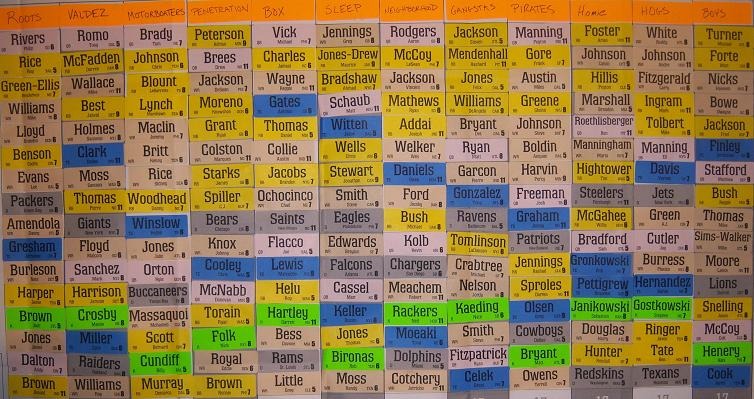What Do Player Rankings Really Mean?

It is often hard to gauge how good a player is without having any measure, especially in Fantasy games, where everything depends on the players' performance. This performance is converted into points, which is how the winners and losers are determined.
In modern times, sophisticated algorithms have popped up that can quickly assess the players' actions and then either provide them with points or take them away. With these points, it is decided how that player is compared to their peers and, therefore, their ranking.
What is Player ranking?
Player ranking is basically a measure of how a player performs in a fantasy sport. Determining how well a player plays is often quite tricky. When you watch players playing soccer, you know that they are good, but you need stats to find out just how good a player is and whether or not it is worth adding them to your team.
In fantasy games, the players are often real-life professional players. Therefore, just by watching their games, you cannot accurately predict their skill compared to others. Here, metrics are vital as they are in-depth scrutiny of a player's skills an
Since fantasy soccer is all about points, player rankings matter a lot. Data was hard to come by in the early days of player rankings, and it was difficult for players to know the standings. However, now you can find all the stats of players and leagues online for free.
Many different factors affect how a player is rated, such as their positions, the games they have played, the number of games they have won/lost, etc.
Furthermore, player rankings often also take into account projections. There are differences between the two but based on projections and other factors, including injury risk and public perception, the final player ranking may change.
Projections, however, are an essential part of player rankings and are based on an actual statistical basis. Those creating these rankings take into account the statistical information of the player from the past to predict how they will play in the future. This method is quite reliable since it is unlikely that a player will change dramatically within a year or two.
Player Ranking Explained
A player's ranking determines how they will perform against another player. If one player has a low ranking, it indicates that they will have difficulty competing with an opponent. It would be easier for them to compete with their opponent if the player had a higher ranking.
Ranking takes into account how the player is perceived as well. They tend to have a higher ranking if they are generally well-liked by the public and consistent.
For example, if a player has been a productive player, has stayed healthy over their career, and is well known and famous, they will have a higher ranking and will be chosen early in fantasy drafts.
The different games in Fantasy sports rank their players differently, and the Fantasy Premier League uses the ICT Index score. This score is quite helpful for managers and allows them to gain insight into the player's performance so that they can plan out strategies and make correct selections.
ICT is a football statistical index, which has been developed to give a verdict on a player and how much of an asset they are as a Premier League Player. This statistical information uses match event data and generates a single score. This score is based on three key areas: influence, creativity, and threat. When combined, they make the player's ICT index score.
A wealth of data is present on most players, which is terrific for assessing the players' performance. However, the ICT index combines all the numbers and makes them easier to digest.
Influence is the degree to which a player has had an impact on a match or throughout the season. It evaluates the importance of the player for his current and future team. Influence takes into account various events and actions which directly or indirectly affect the outcome of a match.
Furthermore, it also processes the various defensive actions to analyze how effective defenders and goalkeepers are.
The creativity of a player asses the performance based on producing opportunities for their team to score goals. Creativity is essential as it helps managers identify players who are more likely to assist.
Therefore, the frequency of passing and crossing is analyzed alongside the pitch location and the overall quality of the ball.
The threat is the value of examining how likely the player will score a goal. Attempts are also taken into account, and the pitch location also gives more weight to actions that are regarded as good chances to score.
Therefore, all of these scores are combined to present the overall ICT index score as a single figure.
The calculations to form the rankings are often done using Z-scores. These are the number of points a player has in each game compared to the standard deviation or how much a particular score is above or below the standard observation of the general public.
Player Projection vs. Player Ranking
Player ranking and player projection are often mixed up, and you may get confused as to which is more accurate. Many sources generate these numbers and often use their tools to gauge a player's importance. However, both of these stats are pretty different from each other but important in their own regard.
Neither of them can be considered scientific, but for those who participate in fantasy football, player projections are much more helpful as they are grounded in stats. Projections are an indicator of how a player will do in the following season.
Those calculating take note of the previous performances of a player and indicate how they might perform in the upcoming matches through a single compiled score.
On the other hand, rankings are much more holistic as they consider multiple factors. They take into account projections, injury risk, and even the public perception of the player. If they are well-liked by the public, they will likely be placed much higher than others. Personal bias is also included to some extent when these rankings are generated.
One of the reasons why public perception is taken into account is that, to some extent, it indicates how consistent a player is. When a player is well-liked, it is usually because the public sees them playing quite often and has become fans due to their performance.
When we compare such a player to another who is not as consistent, the public perception of them would be relatively lower as they do not always perform the same. They may be more skilled, but their lack of consistency makes them a wildcard.
Therefore, both player projection and player rankings are helpful and can make choosing between players easier. Many of the top fantasy sports apps and websites display their ratings alongside the players to make it easier for the participants.
Conclusion
Knowing where a player stands compared to others is extremely useful as it allows you to gauge whether or not they will be a valuable addition to the team. With the internet's popularity, many websites on the internet have player stats available for free. However, it can get quite confusing for a regular player, which is why player rankings are so helpful.
They condense all the information into a digestible value that is both easy to understand and overall extremely useful.




